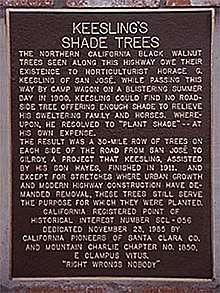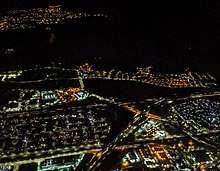Monterey Road
Monterey Road is a major Silicon Valley thoroughfare that runs from Gilroy north to San Jose, California, in Santa Clara County. It follows the historic route of El Camino Real and is an old alignment of U.S. Route 101.
| Monterey Highway | |
 Welcome sign to San Martin on Monterey Road | |
| Maintained by | Cities of San Jose, Morgan Hill, San Martin, and Gilroy; county of Santa Clara |
|---|---|
| Length | 29.2 mi[1] (47.0 km) |
| South end | |
| Major junctions | |
| North end | |
History
The road was established as a stage coach route circa 1856, and paralleled a railroad line built in the late 1860s.[2] It was part of the main road connecting San Jose to Monterey,[3] and incorporated parts of the historic route of El Camino Real connecting California's missions.[2][4] The towns of Gilroy and Morgan Hill sprang up as coach stops along it.[3] In one incident in July 1873, notorious highwayman Tiburcio Vásquez robbed Twenty-One Mile House, a hostel named for its location 21 miles from San Jose along the road, in what is now Morgan Hill.[5]

The Northern California black walnut trees seen along this highway were planted by horticulturist Horace G. Keesling of San Jose. While passing this way by camp wagon on a summer day in 1900, Keesling could find no road-side tree offering shade to relieve his sweltering family and horses, and he resolved to "plant shade" at his own costs. This resulted in a 30-mile row of trees on each side of Monterey road from San Jose to Gilroy, a project that Keesling, assisted by his son Hayes Keesling, finished in 1911. Except for stretches where urban growth and modern highway construction have required removal, these trees still provide the shade that Horace wanted. There is a plaque that is hard to access located on the west side of Monterey Highway (next to the train tracks) in San Jose. 0.5 (one-half) mile south of Capitol Expressway, or 0.34 mile south of Senter Road, or 0.16 mile north of Skyway Drive.
The road became part of the state highway system in the early 1900s and, eventually, it became incorporated into U.S. Route 101 (US 101).[3] By the 1970s, as an expressway with only three lanes (for both directions combined)[6] and high volumes of traffic, it had so many traffic accidents that it became known as "blood alley".[3][7]
In 1973, the section from Monterey Road's southern terminus to Cochrane Road in Morgan Hill was realigned to a 6-lane freeway to the east, and in 1984, US 101 was realigned to a freeway to the east from Cochrane Road to County Route G10 (CR G10). These two realignments restored Monterey Road as a separate road again.[3] Monterey Road continues to exist as a six-lane arterial road within San Jose and as a four-lane highway continuing to Gilroy,[8] and is used as an alternative route to the freeway for commuters.[9]
Monterey Road north of CR G10 was once part of State Route 82 (SR 82), a route that was once US 101 before US 101 was realigned to the Bayshore Highway (now the Bayshore Freeway) to the east in the 1940s.[10] In 2013, a section of SR 82 was relinquished and given to the city of San Jose.[11]
Route description

Monterey Road begins in the southern outskirts of Gilroy, running parallel west of US 101. It runs through Downtown Gilroy and intersects with SR 152. The road then heads northwest through the towns of San Martin and Morgan Hill. Much of this segment runs parallel to the Union Pacific Coast Line. Monterey Road north of Morgan Hill is an outdated and rugged road; it has little changed since US 101 was realigned.[6] The road then heads into the suburbs of San Jose intersecting SR 85 with no direct access to SR 85. After intersecting County Route G10 (CR G10), Monterey Road then heads northwest away from US 101 towards Downtown San Jose. This section from CR G10 to its northern terminus was SR 82 until 2013 when a length of SR 82 was relinquished to the City of San Jose, intersecting CR G21 (Capitol Expressway). Shortly before entering Downtown San Jose, Monterey Road ends at CR G8 (Alma Avenue) and continues northwest as First Street.[1]
Major intersections
The entire street is in Santa Clara County.
| Location | mi[1] | km | Destinations | Notes | |
|---|---|---|---|---|---|
| Gilroy | 0.0 | 0.0 | Bolsa Road | Grade-separated interchange; southern end of Monterey Road; roadway continues as Bolsa Road | |
| 2.0 | 3.2 | Southern end of SR 152 concurrency | |||
| 2.4 | 3.9 | Northern end of SR 152 concurrency | |||
| San Martin | 7.3 | 11.7 | San Martin Avenue | ||
| Morgan Hill | 9.5 | 15.3 | Butterfield Boulevard, Watsonville Road | ||
| 10.0 | 16.1 | Tennant Avenue, West Edmundson Avenue | |||
| 11.0 | 17.7 | Dunne Avenue | |||
| 12.6 | 20.3 | Cochrane Road | Former US 101 | ||
| San Jose | 18.2 | 29.3 | Bailey Avenue | Grade-separated interchange | |
| 22.2 | 35.7 | Bernal Road | Grade-separated interchange; to SR 85 | ||
| 23.3 | 37.5 | Grade-separated interchange; former SR 82 | |||
| 24.8 | 39.9 | Branham Lane | |||
| 25.9 | 41.7 | Grade-separated interchange | |||
| 28.1 | 45.2 | Tully Road, Curtner Avenue | |||
| 29.2 | 47.0 | South 1st Street | Northern end of Monterey Road; roadway continues as 1st Street | ||
1.000 mi = 1.609 km; 1.000 km = 0.621 mi
| |||||
References
- Google (July 12, 2016). "Monterey Road" (Map). Google Maps. Google. Retrieved July 12, 2016.
- Hoover, Mildred Brooke; Mensch, Hero Eugene; Mensch, Ethel Grace; Abeloe, William N. (1966). "The Monterey Road". Historic Spots in California (3rd ed.). Redwood City, CA: Stanford University Press. pp. 431ff. ISBN 9780804740203 – via Google Books.
- "A Road Runs Through It". Morgan Hill Times. August 13, 2004.
- Sharma, U. R.; Morgan Hill Historical Society (2005). Morgan Hill. Images of America. Charleston, SC: Arcadia Publishing. p. 7. ISBN 9781439630891.
Monterey Road in downtown Morgan Hill is a portion of [El Camino Real].
- Boessenecker, John (2010). Bandido: The Life and Times of Tiburcio Vasquez. Norman: University of Oklahoma Press. p. 210. ISBN 0806141271 – via Google Books.
- Buchanan, Eric. "Monterey Highway Southbound". interstate80.info. Retrieved July 11, 2016.
- "Freeway Link near San Jose Needs Finishing". Commentary. Motorland. No. 2. California State Automobile Association. 1974. p. 8.
This latter section is called Monterey Road but the local residents have another name for it—'Blood Alley'. During the past three years it has had three times as many fatalities as the statewide average of four-lane divided highways.
- California Department of Fish and Game (2010). "Chapter 14: Transportation and Circulation". Santa Clara Valley Habitat Plan: Environmental Impact Statement. United States Fish and Wildlife Service. p. 14-3.
- McCormack, Don (2005). Santa Clara, Silicon Valley. Martinez, CA: McCormacks Guides. p. 79. ISBN 9781929365784.
In 2003 the highway was widened by an extra lane in each direction. Big difference but the road still congests: more traffic. For an alternative: Monterey Road, four-lanes: it parallels the freeway.
- California State Assembly. "An act to amend Sections 311, 352, 368, 369, 465, 472, and 496 of, the Streets and Highways Code, relating to state highway routes". Fifty-seventh Session of the Legislature. Statutes of California. State of California. Ch. 1233 p. 2736.
Route 68 is the Bayshore Highway from San Francisco to Route 2 near Ford Road south of San Jose.
- California State Legislature. "Section 300–635". Streets and Highways Code. Sacramento: California State Legislature. Archived from the original on October 6, 2014. Retrieved April 10, 2016.
Section 382: Route (SR) 82 is from Route (I) 880 in San Jose to Route (Interstate) 280 in San Francisco. The relinquished former portion of Route 82 within the City of San Jose is not a state highway ... for the relinquished former portion of SR 82, the City of San Jose shall maintain within its jurisdiction signs directing motorists to the continuation of Route 82 and shall ensure the continuity of traffic flow on the relinquished former portion of SR 82. The city may apply to the department for approval of a business route designation.